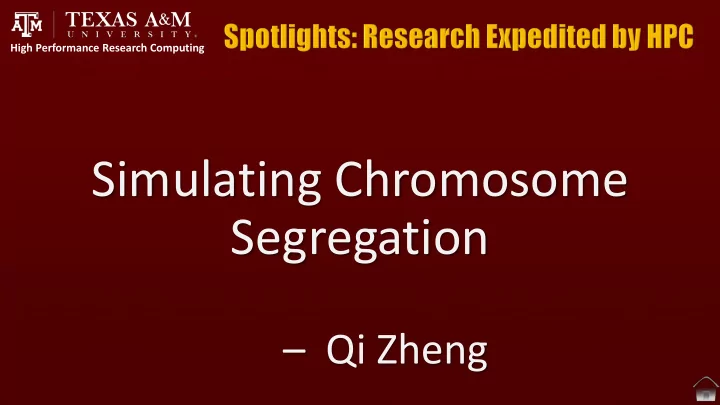

High Performance Research Computing Simulating Chromosome Segregation – Qi Zheng
Simulating Chromosome Segregation Qi Zheng Department of Epidemiology & Biostatistics, Texas A&M University What motivated this study? • The fluctuation experiment of Luria and Delbrück • Growing wild type cells in tubes and let mutation occur • Selecting mutants (e.g., drug resistant mutants) on plates • Computing a mutation rate from the number of mutants
Simulating Chromosome Segregation Qi Zheng Department of Epidemiology & Biostatistics, Texas A&M University Why care about polyploidy? • A cell may have more than one chromosome • A cell has a ploidy value of k if it has k chromosomes • The classic Luria-Delbrück protocol assumes k =1 • Polyploidy complicates the estimation of mutation rates • So we need to take into account the ploidy value when calculating mutation rates • The following cells have a ploidy value of 1, 2, 3, 5 and 8
Simulating Chromosome Segregation Qi Zheng Department of Epidemiology & Biostatistics, Texas A&M University What is the key issue? • A cell having k mutated chromosomes is called a type k cell • With ploidy value = 4, there are 5 types of cells: type 0, type 1, ..., type 4. • If a cell population starts with a type 1 cell, it may eventually have all possible types of cells • With a small probability µ, a wild type chromosome may generate a mutated daughter chromosome • How does a cell population evolve starting with a type 1 cell?
Simulating Chromosome Segregation Qi Zheng Department of Epidemiology & Biostatistics, Texas A&M University What is random chromosome segregation? • In this example cells have a ploidy value of 4 • 8 daughter chromosomes are randomly assigned to 2 daughter cells • A type 2 cell may lead to a type 3 cell and a type 1 cell • But there are other possibilities, e.g.:
Simulating Chromosome Segregation Qi Zheng Department of Epidemiology & Biostatistics, Texas A&M University The fraction of homozygous cells • If a cell contains only mutated chromosomes, call it a homozygous cell for convenience • The fraction of homozygous cells is a function of g , the elapsed number of cell generations, and the mutation probability µ • Current belief: this fraction approaches 1.0 as g increases, at least for cases where the ploidy value is a power of 2 • This claim was derived intuitively • This claim has not yet been subjected to theoretical verification or rigorous simulation testing
Simulating Chromosome Segregation Qi Zheng Department of Epidemiology & Biostatistics, Texas A&M University Tackling the key issue by simulation • Agent based simulation: let each cell be an agent having the number of mutated chromosomes as its attribute • The model was encoded with NetLogo
Simulating Chromosome Segregation Qi Zheng Department of Epidemiology & Biostatistics, Texas A&M University What resources were needed? • For g =25 generations, more than 33 million agents will be generated for each cycle • With so many agents, running the simulation requires a node having 1 TB of random memory • For reliable results, at least 500 cycles are needed • For g =27, it requires a node having 2 TB of memory • It then generates 134 million agents • One cycle of simulation consumes about 1 hour of CPU time
Simulating Chromosome Segregation Qi Zheng Department of Epidemiology & Biostatistics, Texas A&M University What were discovered? • It challenges current belief: the proportion of homozygous cells does not approach 1.0 • When ploidy value = 2, µ =0.001, the asymptotic proportion is about 0.5 • Blue = median proportion, red = mean proportion
Simulating Chromosome Segregation Qi Zheng Department of Epidemiology & Biostatistics, Texas A&M University Conjectures and challenges • Simulations have generated interesting conjectures, e.g.: • There may be unknown simple relations between the ploidy value and the fraction of homozygous cells • Challenges: with ploidy value = 8, g =27 may not be sufficient The author thanks the Texas A&M High Performance Research Computing for technical support. The simulations were performed on an IBM NeXtScale cluster. Contact: qzheng@sph.tamhsc.edu
Recommend
More recommend